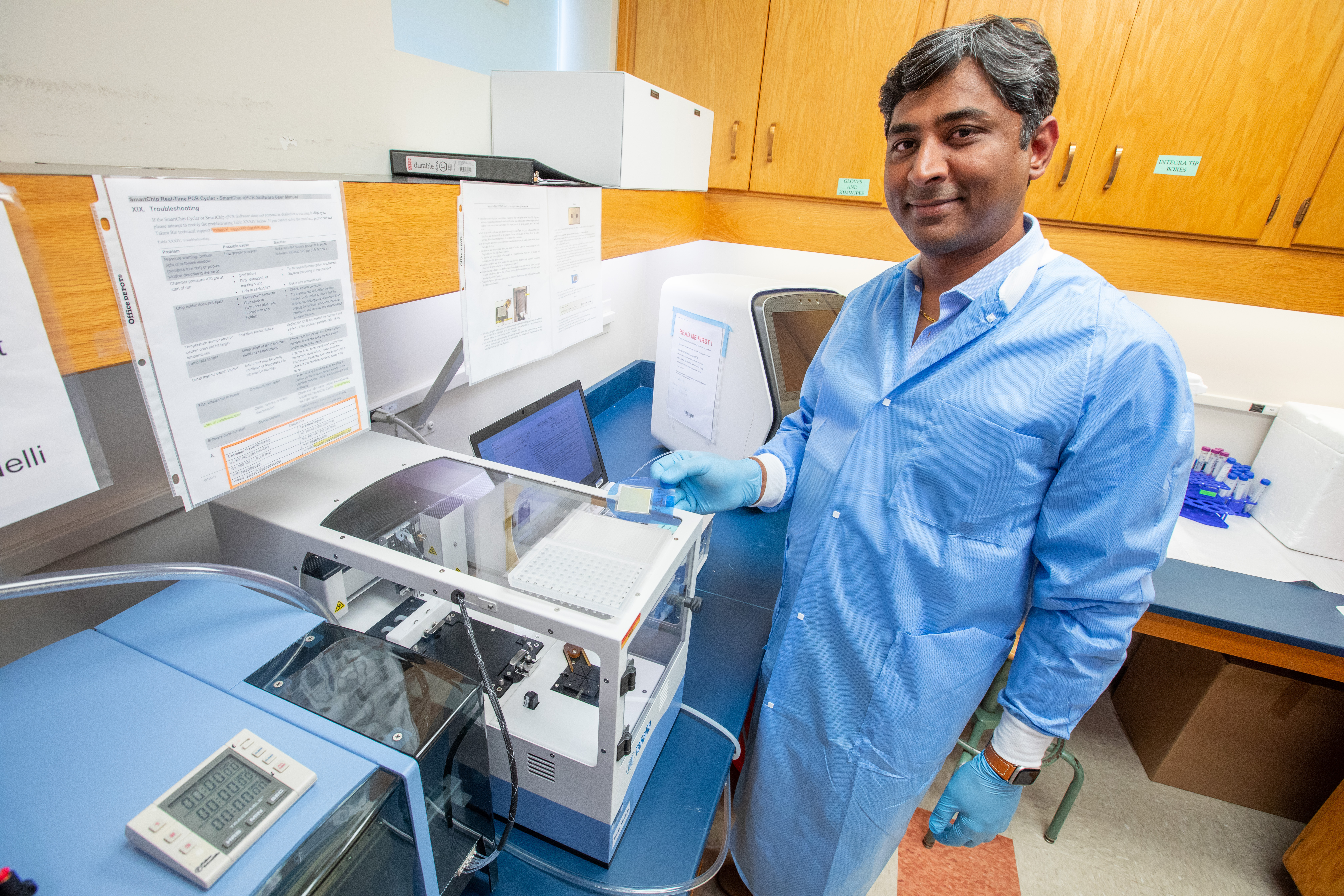
Rahul Nelli, a research assistant professor of veterinary diagnostic and production animal medicine, demonstrates the size of SmartChip testing plate, which can process 5,184 individual samples, compared to plates that hold either 96 or 384 wells. Photos by Christopher Gannon. Larger image.
AMES, Iowa – A machine that holds more than 5,000 samples on a plate no wider than a couple of postage stamps is among the innovations that could vastly enhance molecular diagnostic testing capacity at Iowa State University’s Veterinary Diagnostic Laboratory, advancements that would make tests more affordable and future pandemic-driven surges easier to handle.
The “SmartChip” quantitative polymerase chain reaction (qPCR) testing technology, in combination with a separate 384-sample system that can run 24 hours a day with limited staffing thanks to automated handling features, would give the VDL a needed increase in the volume of diagnostic tests it can process, said Rahul Nelli, a research assistant professor of veterinary diagnostic and production animal medicine.
“The historical patterns of pathogens are changing, so we need to be prepared for risks we haven’t seen before. Having this high-throughput capability will allow us to meet industry needs, providing more cost-efficient diagnostic tests as the need for testing grows,” he said.
Nelli and his colleagues at the VDL were recently awarded a nearly $1 million grant from the U.S. Department of Agriculture’s Animal and Plant Health Inspection Service to help refine the use of the high-volume testing methods, a project funded by the American Rescue Plan Act of 2021 to prepare for future disease outbreaks. Researchers will ensure that the novel high-volume testing methods are accurate and can integrate with existing systems to track and report test results.

The team of veterinary diagnostic and production animal medicine faculty working on the high-throughput testing project includes (from left) associate professor Luis Gimenez-Lirola, professor Phillip Gauger, research assistant professor Rahul Nelli, department chair Patrick Halbur and Veterinary Diagnostic Lab director Rodger Main. Larger image.
“ISU VDL’s first-hand experience in responding to pandemics of high consequence to both animal and human health over the past few years, such as highly pathogenic avian influenza and COVID-19, have clearly illustrated the value of high-throughput testing platforms and need for further innovation,” said Dr. Rodger Main, ISU VDL director.
Technology an ‘enormous asset’ for producers
SmartChip testing relies on microfluidic technology to detect targets of interest in samples of 250 nanoliters or less, a volume 100 times smaller than typical samples tested in the VDL’s standard 96-well machines. Samples are precisely distributed in the chip’s 5,184 testing wells, which are so small they’re barely visible.
“It’s almost like it’s printing the samples because the drops have to hit the bays at just the right force to avoid splashing into the next well,” Nelli said.
Processing that many samples simultaneously allows SmartChip machines to produce up to 30,000 test results per day, compared to about 2,000 tests via the 96-well conventional method. The 384-well machine offers a more moderate increase in capacity based on smaller samples and automated loading, with the potential to handle about 9,000 tests per day.
Nelli envisions the SmartChip testing being held in reserve for spikes in the demand for qPCR tests – a reliable means of detecting trace amounts of genetic material in a sample, including infectious agents in humans and animals. Testing with 384-well automated machines could be part of regular operations in a lab, helping address labor shortages and, by making test prices more affordable, paving the way for wider use of surveillance testing by livestock producers.
“High-throughput testing would be an enormous asset for Iowa State and for producers,” Nelli said.
Over the next two years, in addition to working to incorporate the new testing machines with existing reporting software, researchers will validate the new methods and developing protocols for the wide variety of samples used in veterinary diagnostics, including fluids, fecal matter, egg shells and feathers. The high-capacity testing methods could be ready to be considered for use in the VDL as early as 2025, Nelli said.
“ISU VDL carries the nation’s largest veterinary diagnostic laboratory caseload centered on food animals, routinely conducting more than 650,000 real-time PCR assays each year. Such next-generation high-throughput testing platforms unquestionably have a place in serving the needs of 21st century food animal agriculture,” Main said.








